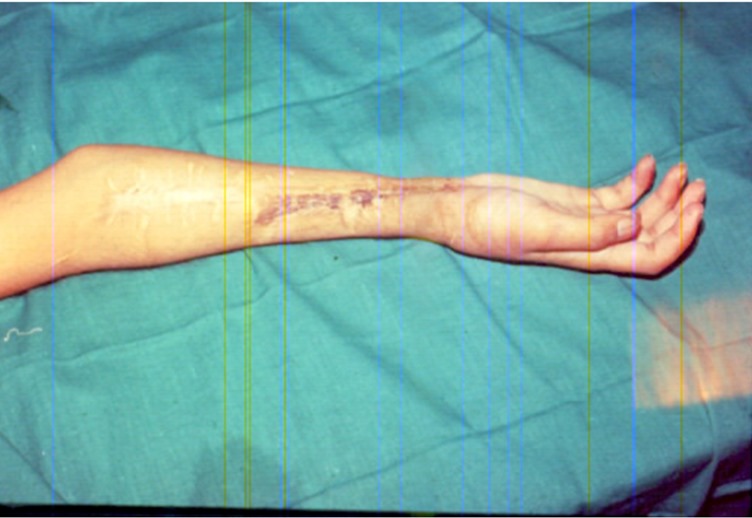It was the year 1991, when a 14-year-old boy fell while riding his bicycle, which broke his right forearm. He was rushed to a nearby hospital and admitted. A plaster cast was applied in the operation theatre under general anesthesia.
However, the plaster turned out to be quite an ordeal and a nightmare which he soon realized. Some complications followed, which were discovered a few days later. Consequently, he was taken up for another round of surgery, where surgical cleaning of the wound was done because a condition called compartment syndrome had set in. The wound was debrided.
Once the debridement or the cleaning of the wound was over, he started facing even more challenges, and further debridement or cleaning of the wound was done. In the sequence of events that unfolded, the median nerve which provides sensation to the thumb, index, and middle finger was also damaged.
The muscles and tendons that bend or flex the fingers were also damaged. In the ensuing days, the bones got infected. The infected radius and ulna bones of the forearm had to be removed to control the infection. The skin was also lost. Without a segment of the bones, the lax flesh of tissue was hanging like a pendulum.
A ray of hope amidst all the misfortune
The boy was even shifted to another hospital in Mumbai to receive better treatment. Another surgery in Bombay (now Mumbai) followed, to join one bone to another in a procedure called a single bone forearm. To his bad luck and utter disappointment, this also failed creating what is in technical parlance called a non-union of the forearm bones.
With time, the wounds had healed but with a scarred forearm. He had very stiff fingers, with no movements. There were ununited forearm bones. There was no sensation in the fingers either. He and the entire family seemed to have lost everything in life as he was issued with a 100% disability certificate. In other words, the certificate stated that there was no hope that he could use his right hand again, as before.
Steps of surgery: Success story and recovery
At this point, we were involved. The parents approached us hoping against hope of any miracle with a 100 percent disability certificate in their minds. After a thorough examination, a treatment plan was outlined including the time frame. To begin with, we decided to mobilize the stiff fingers using dynamic splints. The devices were customized to meet his requirements. It worked very well and the joints could be successfully mobilized. Then we identified and enumerated the problems.
The problems included skin loss, loss of tendons that flex the fingers, loss of nerves that provide sensation, ununited bones, and of course the stiffness of fingers. After tabulating the problems, we found the solutions and identified ways to tackle them. Accordingly, Dr Pankaj Jindal and his team implemented certain customized devices to let the ligaments and tendons get back their strength and sensation.
To start the treatment/therapy, doctors focussed on addressing the bones and joints. For this, they use custom-made devices called external fixators to unite the bones indigenously. On the other hand, they used dynamic splints to mobilize the joints and regain the flexibility of the fingers. Simultaneously, the team conducted continuous physical therapy for about one year until the limbs were restored properly.
The next problem was related to the skin. The skin from the tummy or the abdominal area was transferred to the forearm. This also went on smoothly and so the third target of skin loss had been achieved successfully. So now the two problems were restoration of finger flexion and the sensation because of the nerve loss.
Getting back senses and power all over again
The muscles were powered by tendons mobilized and transferred from the back of the forearm and they were elongated and transferred to the original flexors of fingers. The nerves called Sural nerves were taken from the outer aspect of the legs or the ankle areas. The nerve was reconstructed by grafting the leg’s sural nerve between the two ends of the damaged median nerve with a microsurgical technique to enhance accuracy. So almost all the five steps of the surgery were over. Now, was our turn to wait with a better breath. Sure enough, in a few months, he started showing a flicker of movement. A year after the first visit to us, the movements were much better leading to gaining back the sensation. Thanks to the patience of that little boy, and the perseverance of the parents, we could get an excellent range of motion.
Words would never be enough to appreciate the efficiency of Hand Surgeon Dr Pankaj Jindal in Pune, said the patient. Dr Pankaj Jindal healed his broken forearm and provided enough moral support to achieve his quick recovery. He has obtained all the magic and skills in his hands added the patient. Later this achievement, the person who had not been attending the school, rejoined the school and passed with flying colors. He further went for higher studies and a job in the United States. He later joined a reputed IT company at an IT hub.
Such stories of success and restoration of hand function have been achieved innumerable times in the last 35 years. It is gratifying to recall each of these myriads of stories of hand reconstruction. This has been possible because of the greatest of the teachers of HAND SURGERY, whom I had apprenticed within India, the USA, Switzerland, and France to name just a few.
Dr. Pankaj Jindal
Mobile no. 9822031140
Email: [email protected]
Website: handsurgery.in
Address: Sardesai Clinic, Sardesai Clinic, Lane, Senapati Bapat Rd, opposite Ratna Memorial Hospital, Wadarvadi, Pune, Maharashtra 411016




